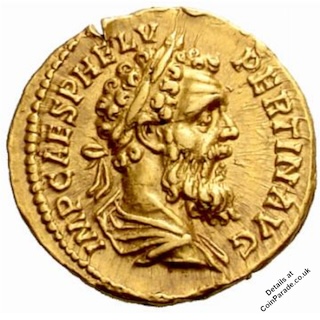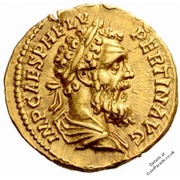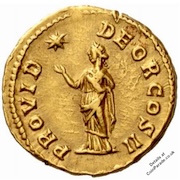
 The 193AD Aureus - Pertinax
The 193AD Aureus - PertinaxGold Aureus of Emperor Pertinax, minted at the Rome Mint in 193AD. Pertinax was the first emperor during the Year of the Five Emperors.
Obverse shows the head of Pertinax facing right. Legend "IMP CAES P HELV PERTIN".
 The Reverse how's Providentia, a divine personification of the ability to foresee and make provision. Legend: "PROVID DEOR COS II".
The Reverse how's Providentia, a divine personification of the ability to foresee and make provision. Legend: "PROVID DEOR COS II".Image credit: CNG Coins (Creative Commons Attribution-Share Alike 3.0 Unported license via en.wikipedia.org).
Mintage: Not known
Minted at Roman Mint
More information (monarch, year, mint, country, category) can be found below coin listings.
Below are some coins currently being offered on eBay. As an eBay Partner, We may be compensated if you make a purchase.
List items on:
List items on:
Pertinax (Emperor 193AD-193AD)
Classification: Roman Emperor, Roman Imperial (96-235AD)Reign: 01-Jan-0193 - 20-03-0193.
Publius Helvius Pertinax (1 August 126 – 28 March 193) succeeded Commodus to become the first emperor during the Year of the Five Emperors. He was Roman emperor for the first three months of 193AD. Pertinax was born as the son of a freed slave, and he died when assassinated by members of the Praetorian Guard.
Regnal name: Imperator Caesar Publius Helvius Pertinax Augustus
CAESAR PVBLIVS HELVIVS PERTINAX AVGVSTVS
Category: Roman
The Roman Empire was one of the largest Empires in history, covering most of Europe, Britain, parts of Asia, the Middle East and North Africa. It was in existence from 27BC to 476AD, more than 500 years. And all these places used Roman coins throughout the era.Originally coins were minted only in Rome, but by the third Century there were mints in other countries too. These mints sometimes produced more than 2 million coins per month to meet demand. Coins typically depicted the Emperor on one side and some other image or letters on the other. During the Empire, more than 10,000 different types of coins were created using copper, silver and gold.
Roman coins are usually classified as:
- Roman Republican Coins (about 300BC - 27BC)
- Roman Imperial Coins (27BC - 96AD)
- Roman Imperial Coins (96AD - 235AD)
- Roman Imperial Coins (235AD - 476AD)
- Roman Provincial Coins
The Denarius was the standard Roman silver coin and there were a range of others. As a guide, in the early republic (after 211BC) there was the Sestertius (=4 denarii), Dupondius (=5), As (=10, a tenner), Semis (=20), Quincunx (=24), Triens (=30), Quadrans (=40), Uncia (=120) and Solidus (=1000, it was gold). Values fluctuated later due to debasement and inflation.
The exchange values were as follows:
1 gold aureus = 25 silver denarii
1 silver denarius = 16 copper asses
1 brass sestertius = 4 copper asses
1 brass dupondius = 2 copper assses
1 copper as = 2 copper semisses (or 4 copper quadrantes)
The standard gold coin was the Aureus and was equal to 25 denarii or 100 sestertii. It's not far off the weight of a modern gold sovereign. The Aureus was introduced by Julius Caesar around 49BC and was the principal gold coin until about the 4th century when it was replaced by the gold Solidus.
The great part of this is that you can put together a really nice Roman coin collection with very little money, as many coins (although not all) are common and inexpensive. The coins are the best part of 2000 years old and are exciting to collect.
For more information see our articles:
Which Mint: Roman Mint
The origins of the Rome mint are from the manufacture of a silver coin near to the Temple of Juno Moneta back in 269BC. Juno was the personification of money.Due to the size of the Roman Empire, Rome could not produce all the coins needed and Roman mints were set up in 27 locations, and there were more than 600 provincial mints scattered about the Empire. During overseas campaigns, Generals such as Caesar and Marc Anthony would mint their own coins to pay their armies.
Mint marks were used on the coins to differentiate the mint of manufacture.
Country of Origin: Roman Empire
The Roman Empire ran from 27BC to 476AD and was the post-Republican period of ancient Rome. It covered a large territory of Europe, Northern Africa, and Western Asia. It was ruled by an Emperor.






